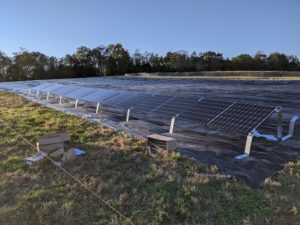27 Oct OWASA Goes Solar
 With the help of several local, state, and national partners, OWASA will unveil its first solar project this November on the sunny, gently sloping field near two mixing tanks on Berry Andrews Road, about 15 minutes outside of Carrboro. This solar array will soon be followed by two more in early 2021, on the roofs of the administration building and operations center at OWASA’s Jones Ferry Road campus.
With the help of several local, state, and national partners, OWASA will unveil its first solar project this November on the sunny, gently sloping field near two mixing tanks on Berry Andrews Road, about 15 minutes outside of Carrboro. This solar array will soon be followed by two more in early 2021, on the roofs of the administration building and operations center at OWASA’s Jones Ferry Road campus.
OWASA’s Board of Directors approved an Energy Management Plan in 2017 that committed the utility to using energy more efficiently, using renewable energy sources, and reducing greenhouse gas (GHG) emissions. The plan set an ambitious goal to reduce the use of purchased electricity by 35% by 2022 from a 2010 baseline.
“By reducing our use of energy and increasing our use of renewable energy sources, we can do so many things to help our community: improve environmental impact of our operations, reduce costs, improve reliability and resiliency,” explained Mary Tiger, OWASA’s Sustainability Manager. “The first years of the plan really focused on energy efficiency and conservation. We were able to reduce our purchased electricity use by almost 30%, but this is part of the last big push we needed to get us to our goal.”
According to a 2017 report by the Congressional Research Service, energy consumption by public drinking water and wastewater utilities can represent 30%-40% of a municipality’s total energy bill. OWASA’s water and wastewater facilities used almost 16 million kilowatt hours (kWh) of electricity in 2019. For comparison, the Town of Chapel Hill’s municipal buildings used 4.7 million kWh in 2005.
The first solar array project will eventually produce a little more than 200,000 kWh of clean, renewable energy every year, off-setting almost half of the electricity used to run the mixing tanks.
The two additional roof-mounted solar arrays will bring OWASA’s total clean energy portfolio to 308 kW DC, generating almost 428,000 kWh of clean energy annually and offsetting 2% of OWASA’s 2010 baseline for purchased electricity. In total, these three projects will reduce OWASA’s greenhouse gas emissions by an estimated 116 metric tons of carbon dioxide equivalent (MTCO2e) annually.
“Back in 2018, the economics of solar were almost impossible. We couldn’t make it work. But then NC House Bill 589 passed, and Duke Energy came through with their solar rebate package for non-profits like OWASA, which totally flipped the script,” Tiger said, with a huge grin on her face. With the $75,000 rebate from Duke Energy and an innovative 25-year solar lease with Eagle Solar and Light, starting in year one, the savings from the solar projects will exceed the annual lease payment.
This reduces operating costs and, ultimately, keeps service affordable for customers while reducing OWASA’s impact on the environment.
“OWASA has shown what is possible for other non-profits, utilities, and municipalities to meet the community’s demand for cleaner energy. My hope is that other groups follow OWASA’s example,” added Eagle Solar and Light’s Managing Director Scott Alexander.
“Four of OWASA’s core values came together in an extraordinary way on this project: Environmental Stewardship, Affordability and Value, Sustainability, and Innovation,” OWASA Executive Director Todd Taylor summed up. “We’re saving money, saving energy, cutting our greenhouse gas emissions, and working with our partners to come up with real solutions that work for our community.”



